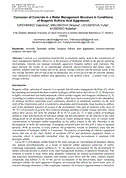[1]
D. Goncharenko, Operation, repair and restoration of sewerage networks: Monograph, Kharkov, Konsum, 2008.
Google Scholar
[2]
S.A. Zabelin, A.I. Aleynikova, Modern approach to the study of biogenic corrosion of sewage collectors Collection of scientific works of the Ukrainian State University of Railway Transport, 172 (2017) 20–36.
DOI: 10.18664/1994-7852.172.2017.116629
Google Scholar
[3]
V.A. Iurchenko, Development of scientific and technological foundations for the operation of sewerage facilities under conditions of biochemical oxidation of inorganic compounds: diss.doctor of tech. Sciences 05.23.04, Yurchenko Valentina Aleksandrovna. UGNII "UkrVODGEO", Kharkov, 2007.
Google Scholar
[4]
G. Drozd, N. Zotov, V. Maslak, Sewer pipelines: reliability, diagnostics, sanitation, Donetsk, IEP NAS of Ukraine, 2003.
Google Scholar
[5]
K. Tsytlishvili, N. Rashkevich, D. Poltavska, Research of Modern technologies of Wastewater Treatment of Food Products Combined with Ozonation and Hydrogen Peroxide. Key Engineering Materials, 925 (2022) 169–178.
DOI: 10.4028/p-t5m3y6
Google Scholar
[6]
V. Iurchenko, V. Sierohlazov, O. Bryhada, O. Melnikova, L. Mykhailova, Hydrogen Sulphide in Industrial Enterprises Water Management Infrastructure - The Factor of Chemical and Microbiological Corrosion Concrete Degradation of Water Facilities. Materials Science Forum ISSN 1662-9752, 1038 (2021) 401–406
DOI: 10.4028/www.scientific.net/MSF.1038.401
Google Scholar
[7]
Q. Dong, Н. Shi, Y. Liu, Microbial character related sulfur cycle under dynamic environmental factors based on the microbial population analysis in sewerage system, Frontiers in microbiology, 8 (2017).
DOI: 10.3389/fmicb.2017.00064
Google Scholar
[8]
D. Stein, Rehabilition and Maintenance of Drains and Sewers, Univ.-Prof. Dr.-lng. habil. Ruhc-University Bochum (RUB), Faculty of Civil Engineering, Germany, 2001.
Google Scholar
[9]
D.F. Goncharenko, A.I. Aleinikova, R.I. Gudilin, Sewer tunnels and collectors - on the verge of ecological catastrophe, Scientific bulletin of everyday life, 4 (93) (2018) 110–115.
Google Scholar
[10]
O.V. Brigada, Monitoring of indicators of exploitation of drainage structures made of reinforced concrete: author's thesis dissertation candidate of sciences 05.23.04, Kharkiv National University of Life and Architecture, Kharkiv, (2013) 24.
Google Scholar
[11]
E.I. Andreyuk, V.I. Bilay, E.Z. Koval, I.A. Kozlova, Microbial corrosion and its pathogens, Kyiv, Naukova Dumka, 1980.
Google Scholar
[12]
A.V. Kovalenko, V.O. Iurchenko, E.V. Brigada, E.S. Lebedeva, Protection of atmospheric air from pollution by hydrogen sulfide emissions from sewage networks. Scientific bulletin of construction, Kharkov, Khnuba, Hotv, ABU, 3(77) (2014) 218–223.
Google Scholar
[13]
J. Monteny, E. Vinckeb, A. Beeldensc, N. De Belied.,L. Taerwea, D. Van Gemertc, W. Verstraeteb, Chemical, microbiological, and in situ test methods for biogenic sulfuric acid corrosion of concrete, Cement and Concrete Research, 30 №4 (2000) 623–634.
DOI: 10.1016/s0008-8846(00)00219-2
Google Scholar
[14]
V.A. Iurchenko, E.V. Brigada, Kinetic characteristics of microbiological corrosion of concrete in sewer networks. Water and ecology, Problems and solutions, 1 (2014) 51–61.
Google Scholar
[15]
C.A. Loto, Microbiological corrosion: mechanism, control and impact – a review, The International Journal of Advanced Manufacturing Technology, 2 (2017) 1–12.
Google Scholar
[16]
L. Routil, M.Chroma, B.Teply, D.Novak, Prediction of the time-variant behaviour of concrete sewer collection pipes undergoing deterioration due to biogenic sulfuric acid, In CONCREEP, 10 (2015) 219–228.
DOI: 10.1061/9780784479346.026
Google Scholar
[17]
M. Basista, W. Weglewski, Micromechanical modelling of sulphate corrosion in concrete: influence of ettringite forming reaction, Moscow, Belgrade, Theoret. Appl. Mech, 35 №1–3 (2008) 29–52.
DOI: 10.2298/tam0803029b
Google Scholar
[18]
Recommendations for assessing the degree of corrosive effect of slightly aggressive acid environments on concrete. Moscow, NIIZhB, (1986) 14.
Google Scholar
[19]
B.V. Gusev, A.S. Faivusovich, V.F. Stepanova, N.K. Rozental, Mathematical model of concrete corrosion in liquid media, Izv. Universities, Construction, (1998) 56–60.
Google Scholar
[20]
DSTU ISO 22016:2018 Determination of sulfur in refractory products and raw materials by gravimetric, photometric and titrimetric methods (ISO 22016:2015, IDT). Kyiv, 2019 [in Ukrainian].
DOI: 10.3403/30276978
Google Scholar
[21]
DSTU B V.2.7-202:2009 Cements and materials for cement production. Methods of chemical analysis, Kyiv, 2010 [in Ukrainian].
Google Scholar
[22]
E.V. Arinushkina, Guide to the chemical analysis of soils, Moscow, Publishing house of Moscow State University, 1970.
Google Scholar
[23]
List of methods for performing measurements (determinations) of the composition and properties of samples of environmental objects, emissions, wastes and discharges provisionally allowed for use by the State Inspectorate of Ukraine, approved by the Head of the State Environmental Inspectorate of Ukraine - Chief State Inspector of Ukraine for Environmental Protection on 01.03.2013 [in Ukraine].
DOI: 10.24195/2414-9616.2019.3.3
Google Scholar
[24]
L.N. Popov, Laboratory testing of building materials and products, Moscow, Higher school, 1984.
Google Scholar
[25]
DSTU 7909:2015 Soil quality. Determination of sulfate ion in aqueous extract. Kyiv, 2016 [in Ukrainian].
Google Scholar
[26]
DSTU 7945:2015 Soil quality. Determination of calcium and magnesium ions in water extract. Kyiv, 2016 [in Ukrainian].
Google Scholar
[27]
DSTU B V.2.6-145:2010 Structures of buildings and structures. Protection of concrete and reinforced concrete structures from corrosion. General technical requirements (GOST 31384-2008, NEQ) Kyiv, 2010 [in Ukrainian].
Google Scholar
[28]
V.A. Iurchenko, I.V. Korinko, V.G. Mykhaylenko, O.M. Kovalenko, S.S. Piligram, B.K. Zelenskyi, O.V. Brygada, P.I. Onatskyi, D.IS. Borisevich, The device for determining the parameters of the condition of concrete structures that are affected by sulfuric acid aggression "Concrete Corrosimeter". Patent 25294 of Ukraine IPC 2006 G01F 23/28 (Ukraine). - u 2006 133612006. Application 18.12.2006. Publ. 10.08.2007. Bul. No. 12. 8 s.
Google Scholar

